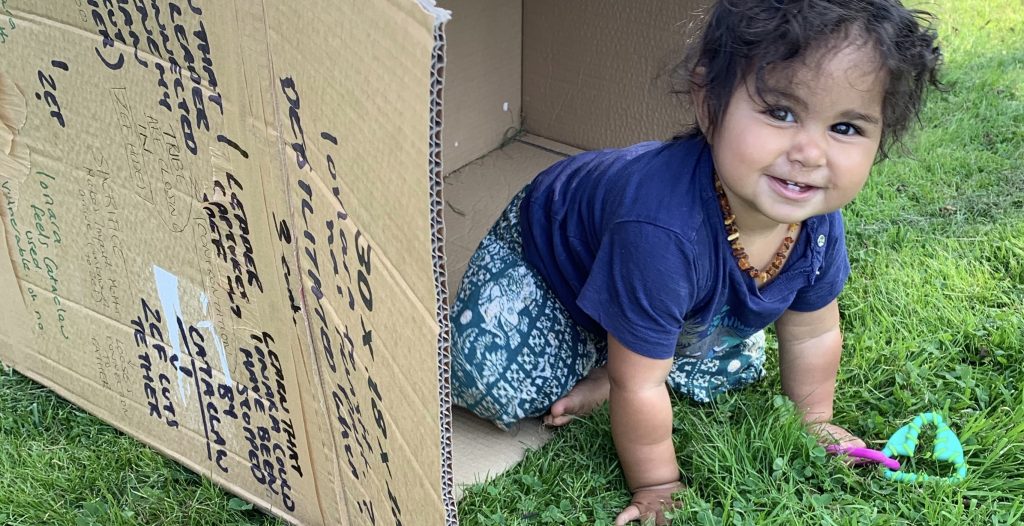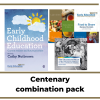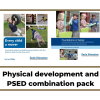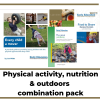How nurseries show community leadership and create happier local neighbourhoods
by Mona Sakr Nurseries are at the heart of enabling children to positively contribute to the communities they live in. Through their work with children
Toddlers are very busy people. They are keen to learn about the world around them and ready to be fascinated by things that seem ordinary to you. They can spend part of a morning thrilled to run around the park – getting better at starting, stopping, going forwards then backwards, and at making quick right turns. Then they might stay still for ages, turning over stones and twigs. If all is going well, toddlers change completely in their second year of life. They are able to move around independently. They talk in their own words and understand more of what you say.
Toddlers love playing around with interesting materials. They need a good store of things to play with, but they don’t all need to be bought toys. Before you spend your money, look carefully at a toy. Can toddlers use it in different ways? Will it add to what they enjoy already? A lot of shop-bought toys are advertised as being good for “early learning”. But toddlers learn by having lots of different experiences, not by playing with just a few plastic toys. If a toy has limited interest, toddlers will soon abandon it for the more interesting box that it came in. Spend your money on play materials that you cannot make or gather together. Here are some good ideas for toys either to buy or to gather together from what you already have.
Toddlers learn through having time and space to practise. They repeat actions, often with slight variations. In this way they get to understand how things work. They become confident about what causes what, and what will fit or not. Try hard to look beyond the apparent mess to what toddlers are exploring and what they have learned. Of course, it is sensible for you to make some ground rules like “Paint or play dough stays on this table on the plastic cloth”.
Make it easier for toddlers to be part of tidying up by giving time for the finding, wiping and putting back into containers or baskets.
Toddlers do not only learn through what adults think of as play. They learn a great deal when you get out with them into the neighbourhood. An ordinary local circuit interests toddlers and very young children. On a local walk or trip to the shops, allow enough time for them to stop and stare. Toddlers say and show that they remember a familiar corner as well as point out the newly arrived crane on the building site. Toddler general knowledge is built through ordinary experiences such as posting letters, buying some bread and watching a big black beetle cross the pavement.
Once toddlers are mobile, they are keen to be your apprentice in ordinary domestic routines. Give them some extra time, then toddlers feel helpful.
It will be a long haul before toddlers can take care of themselves completely. They cannot practise feeding themselves or putting on a jumper if you are usually tempted to do it, to save on mess and time. Quicker is not always better, once you home in on chances for toddlers to learn in the longer term. As well as the physical skills, they learn about cause and effect: what follows what and simple forward planning.
Really early literacy matters, and the best way to encourage it is by enjoying books with toddlers. Notice when they have favourites and be ready to read those many times. They enjoy dramatic pauses and repeating phrases that they can say as well. Some toddlers start to tell themselves the story and show that they already understand how books work – by turning the pages the right way, or perhaps saying “The end” when the story is finished. Toddlers need to find out that pictures stand for real objects. Be excited when they link what they see outside – a big sunflower or a fire engine – to the picture in their book.
Nursery rhymes help children understand sound patterns in a way that will help them to read and write later on. They also help children learn the detail of the many sounds that make up language.
Between their first and second birthdays, toddlers learn enough about how their world works to start imagining things and playing “pretend”. The first pretend actions are often short – a toddler might pretend to feed using an empty spoon. But soon they will pretend by putting Teddy to bed or moving their cars along a “road”. Toddlers start to make look-and-say jokes, like pretending a bowl is their hat or calling somebody by the wrong name on purpose. Their grin says, “You know that I know that you know that this is all just pretend”.
There’s a lot going on inside a toddler’s head. But it can be hard for adults to understand the way they think. There is a temptation to rush them on to ideas like colour or shape. These ideas seem obvious to us, but there is no good reason to act as if colour and shape are more important than any of the other ideas that toddlers are beginning to grasp.
It is really useful to understand how language unfolds. First of all, toddlers learn words that are the names of familiar people and objects. Then they learn words that stand for actions. Only then do they start to have the words that describe their world, that are about ideas. This development is usually in the second part of the second year of life. Listen to older toddlers and you may hear “big”, “high”, “tasty”, “hot”, “smelly” and other words for ideas. Such words cannot make sense until toddlers have plenty of words for naming and actions, because the words need to link together. “Big”, “high” and “hot” are ideas words that cannot stand alone. You cannot have a big – a bus is big.
You can help toddlers make the exciting move into ideas when you watch and listen to what makes sense so far. There is no rush to get them to learn. Instead, drop the words into conversation at a sensible opportunity. For example, “Would you like your blue trousers today?” or “Gosh that was a loud sneeze!” Notice and be excited about any words that include ideas. Colour and shape will come in good time.
Jennie Lindon is a chartered psychologist, with over 30 years’ experience of working with early years services for children and their families. She has written many books and magazine articles for parents and early years practitioners.

by Mona Sakr Nurseries are at the heart of enabling children to positively contribute to the communities they live in. Through their work with children
The Families’ Access to Nature Project was undertaken by the Froebel Trust and Early Education between October 2021 and January 2022. Children, their parents, and
ICT – what’s it all about? ICT is information and communications technology. The term simply means all the technology around us, things like mobile phones,
Children’s curiosity about the world around them is apparent from the day they are born. Babies quickly use all their senses to explore themselves and
Reading is fun. It’s also a key skill that helps us to learn and to live our lives – so starting to read is an
What? Why? When? Where? What for? – and Why? yet again. Sometimes children’s questions just keep on coming. It can be wearing, especially if you
It’s true, maths really is everywhere, and learning about it doesn’t happen just at school or nursery. Young children have lots of important mathematical experiences
What is mark making? Mark making is the term used to describe the marks that children in their early years make on paper and is
The role of music in the early years Everyone knows how much young children love to sing and dance, but all too often music is
Children learn how to behave All children are individuals, because they are born with their own character. This is why even children within the same
Early childhood seems like a time of constant change to adults. Just as you’ve got used to a predictable daytime nap, your child decides that
Why go outside? Big movers Have you ever been in an open space with young children? The first thing they want to do is to
Young children are artists. They use all sorts of materials to show what they have noticed about the world. They might draw the rain falling
Taking care of a baby is tiring work, with a lot of feeding, nappies and broken nights. When you are exhausted, it can be harder
Here are twelve links with free ideas to support play and learning at home, suitable for early years, nursery, reception and school aged children in
It is important to include families in helping to shape your decisions in relation to developments you want to make. Families know their circumstances best
Since the introduction of the EYFS framework in 2008 there has been a huge emphasis upon encouraging parents to become engaged in their children’s learning.
The Duchess of Cambridge launched The Royal Foundation Centre for Early Childhood on 18th June 2021 with a substantial report Big change starts small which identifies six
Entering the unknown It was extremely hard and emotional to say goodbye to the children and parents in my Reception class at the end of








Early Education
2 Victoria Square
St Albans
AL1 3TF
T: 01727 884925
E: office@early-education.org.uk